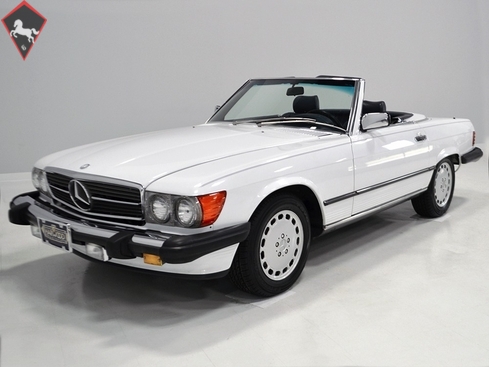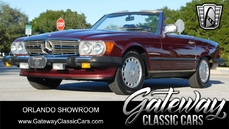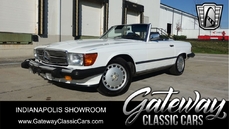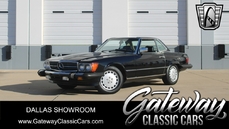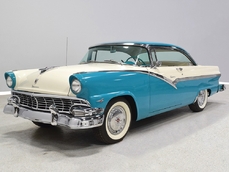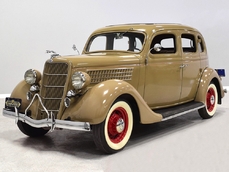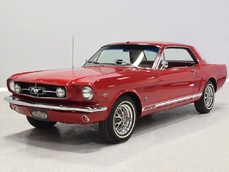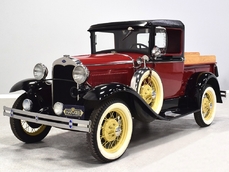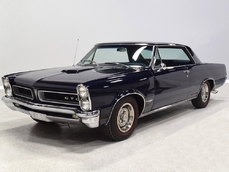Mercedes-Benz 560SL w107 5.6 liter OHC V8 1989
General description :
If I had to name one all-purpose car, one that does everything well, can go to any event and fit in, and still provide reliable daily transportation—in addition to being interesting and fun—I would have to pick the venerable Mercedes-Benz R107 SL. Even 45 years after their introduction (yes, it’s been that long) they are still highly regarded as a status symbol and to anyone outside the hobby, it is seen as an outrageously expensive machine. They are also bulletproof reliable when properly maintained, and maintenance isn’t nearly as expensive as you think it is. And finally, with V8 power, two seats, and a suspension that’s the ideal combination of comfortable and sporting, you can live with it every day. If you can have just one car, there’s a very compelling argument in favor of this 1989 Mercedes-Benz 560SL.
Of course, to discerning collectors, the R107 to own is the latest and greatest, the 560SL. Bigger motor, more power, better interior, upgraded features, all of those combine to make it the most appealing of the bunch. This particular 560SL was built in the final year of production, 1989, and is the pinnacle of the breed’s evolution. Finished in classic white with a navy blue leather interior, it is traditional and elegant, yet sporting. And like many of its siblings, it has led a pampered life away from the ravages of daily commuting and harsh weather. Instead, it appears to have been a fair-weather toy for someone very wealthy, which is just what you want. It has always been properly serviced and the fantastic shine on the nearly 30-year-old paint speaks to the care it has received. It has never been hit or dinged, so that’s 100% factory-applied paint and nobody really knows how to do it better than Mercedes-Benz itself. You also get the ingot-like structure with doors that slam shut with precision that you can’t find today, and assembly quality was first-rate, as you’d expect. It is rumored that this is one of the last Mercedes-Benz vehicles to have been designed by the engineers rather than the marketing department, which would certainly explain their legendary quality and reliability.
Other details on this car show off its care better than the paint. Look at the rubber bumpers, which are still black, supple, and smooth, all indications that this car has not been baked in the sun. The chrome portion of the front bumper has been replaced at some point due to a small ding that couldn’t quite be erased by a body shop (not even the grille was harmed so no worries about serious damage), but the rest of the brightwork is 100% original. The last of the R107s also benefit from a smaller, less conspicuous CHMSL (center high-mounted stop lamp) on the trunk lid, so it looks a bit sleeker than its older siblings. And as you can see, all the lenses are bright, clear, and bereft of hazing, all evidence of a car that has lived a majority of its life indoors and protected.
Another perk of owning a late 560SL is that leather upholstery was standard. With a sticker price approaching $80,000 in 1989 dollars, there was really no excuse for anything other than the best materials, and the long-wearing hides remain in fantastic condition today. Yes, of course there are a few signs of use, some creases on the lower cushion, and maybe a scuff or two on the driver’s outer bolster, but for decades-old leather to be this nice is rather unusual. The rest of the interior is equally nice, with plush carpets that show minimal fading, genuine burled walnut veneers on the center stack that are not split or delaminating, and a matching dark blue dash pad that has zero cracks or discoloration. All of the big, round gauges are fully operational, including the VDO temperature gauge in the center vent, which is indeed factory equipment, not a homemade add-on. Thanks to a recent service, the A/C blows cold, the windows glide smoothly up and down (Mercedes windows are a little slower than the rest of the world, so don’t fret about it), and even the power passenger-side mirror works properly. The driving position is comfortable and commanding, with a massive steering wheel that was also wrapped in leather for the 560, and the view down that long hood is impressive. There’s an AM/FM/CD stereo head unit in the center stack, which was state-of-the-art for entertainment systems in 1989, and the power antenna connected to it works properly as well. Overhead, there’s a matching blue canvas convertible top that’s in excellent condition, as well as a matching white hardtop that seals it up as well as a hardtop. The trunk is upholstered in the same plush, expensive carpeting as the interior, and includes a built-in first aid kit, as well as the original spare tire, which has never been on the ground.
But the real reason you buy a 560SL is the power, complements of a 5.6 liter SOHC V8. This was a huge step forward over the previous 380SL and transforms the R107 from a competent cruiser to a downright quick German muscle car. Still built with legendary Mercedes-Benz durability, it added almost 100 horsepower and a mountain of low-end torque. It flings the SL around with ease and even today it feels fast. Thanks to proper maintenance over the years, this one has exactly zero issues, starting quickly hot or cold, idling smoothly, and running with a mellow V8 rumble that feels incredibly addictive. The engine bay shows signs of care but it isn’t detailed for show, so don’t have any worries about driving it. Those who know these cars realize that the 101,000 miles showing on the odometer are a non-issue for a properly maintained car, and this car has a great deal of life left in it, make no mistake. By 1989, the timing chain tensioner issue had been resolved, making this a low-maintenance car that makes very few demands on its owner. Follow the manual and it should run pretty much indefinitely.
The other upgrade that came with the 560SL was a 4-speed automatic transmission with overdrive, making it an incredible high-speed cruiser. Linked to 2.47 gears out back, it just loafs along at speeds that will get you jail time in many states and even though it has a big, burly V8, fuel economy is reasonable. In true Mercedes-Benz fashion, it starts out in second gear for maximum smoothness, but a quick mash of the accelerator and it’ll drop into first and take off with shocking ferocity—be sure it’s aimed where you want it to go! ABS was added to the 560’s roster of standard features as well, so the already powerful brakes are now world-class and inspire confidence at virtually any speed. The ride is supple, never harsh, but you’ll find that when you need to hustle, the SL is right there with you and never seems to put a tire wrong. 15-inch wheels were an upgrade over the former 14s and have the now-familiar Mercedes-Benz look as well as a set of recently-installed 205/60/15 performance radials.
Complete with the original books, manuals (yes, the service manual has been stamped), and even the original window sticker, this car has a great pedigree. It also includes the original tool roll with all the tools intact plus a stack of recent service receipts. These things matter and you can buy this car with confidence.
We’ve sold a lot of R107 SLs, and they continue to impress us with their versatility and competence. As I said, if you could have just one car that does everything well, this beautiful 560SL might be my first choice. Call today!
http://www.harwoodmotors.com/vehicles/inventory_details.php?id=788
1989 Mercedes-Benz 560SL w107 5.6 liter OHC V8 is listed sold on ClassicDigest in Macedonia by for $25900.
Car Facts
Car type : Car Make : Mercedes-Benz Model : 560SL w107 Model Version : 5.6 liter OHC V8 Engine size : 5.6 Model Year : 1989 Location : Ohio
Sold
Seller Information
Sold
People who viewed this Mercedes-Benz 560SL w107 also viewed similar Mercedes-Benz listed at ClassicDigest
Other cars listed for sale by this dealer
About Mercedes-Benz
In the annals of automotive history, the journey of Mercedes-Benz is a tale that unfolds with the ingenuity of its founding pioneers. In the year 1886, Karl Benz crafted the Benz Patent Motorwagen, a creation that would go down in history as the world's inaugural automobile. Unbeknownst to him, this moment marked the genesis of what would evolve into the most illustrious premium car manufacturer globally. The financial underpinning of this pioneering venture, interestingly, was provided by Karl Benz's wife, Bertha Benz, demonstrating a remarkable partnership that would set the tone for Mercedes-Benz's legacy.A parallel narrative emerged not far away, as Daimler-Motoren-Gesellschaft, founded by Gottlieb Daimler and Wilhelm Maybach, entered the scene. In 1901, they unveiled their automobile under the now-famous moniker "Mercedes," meaning "godsend" in Spanish. This name was bestowed upon the car at the behest of Emil Jellinek's daughter, the distributor for Daimler-Motoren-Gesellschaft. The wheels of innovation were set in motion.
Fast forward to 1926, a pivotal year that witnessed the merger of Daimler with Benz & Cie., culminating in the birth of Daimler-Benz. The amalgamation saw the adoption of "Mercedes-Benz" as the distinguished trademark for their automobiles, fusing the legacies of two visionary entities into one.
Contrary to perceptions of conservatism, the trajectory of Daimler-Benz unfolds as a chronicle of industry firsts. From the introduction of the honeycomb radiator to the float carburetor, and the pioneering implementation of four-wheel brakes in 1924, Daimler-Benz consistently pushed the boundaries of automotive innovation. The diesel-powered Mercedes-Benz 260 D in 1936 marked the inception of diesel engines in passenger cars. The iconic Mercedes-Benz 300SL Gullwing made history as the first car with direct fuel injection, albeit the Gutbrod's tiny 2-stroke engine can claim precedence.
Safety innovations became a hallmark, with Béla Barényi's patented safety cell design in the "Ponton"-models in 1951, featuring front and rear crumple zones. The W116 450SEL 6.9 saw the introduction of the Anti-Lock Brake system (ABS), another pioneering safety feature. From the first production airbags and beyond, the legacy of "firsts" continued to be etched into the fabric of Daimler-Benz.
Over its centennial journey, Mercedes-Benz has not merely produced cars but has sculpted automotive icons. The SSKL, 710 SSK Trossi Roadster, 770K Grosser, 540K Spezial Roadster, 300SL Gullwing, w100 600 Pullman, w111 280SE 3.5 Flachkühler, w113 230SL Pagoda, w109 300 SEL 6.3, and w201 2.3-16 Cosworth stand testament to the brand's commitment to engineering excellence.
The roaring Silver Arrows, or "Silberpfeile," including the W 25, W 125, W154, W165, and W196, created a legacy of dominance on the racetrack. These machines were not merely cars; they were expressions of precision, speed, and an indomitable spirit that left their competitors in the dust.
As Mercedes-Benz marches into the future, it does so not just as an automaker but as a custodian of a legacy, a torchbearer of innovation, and a beacon of automotive excellence. The road ahead is sure to witness the continued fusion of cutting-edge technology, timeless design, and an unwavering commitment to setting new standards in the world of automobiles.
One luminary figure who left an indelible mark was Béla Barényi, often heralded as the "father of passive safety" for his pioneering work in safety engineering. His patented safety cell design, featuring front and rear crumple zones, became a hallmark of Mercedes-Benz's commitment to occupant safety, setting new standards that reverberated throughout the automotive world.
Moving through the chronicles, the collaborative genius of Wilhelm Maybach, alongside Gottlieb Daimler, laid the foundation for Daimler-Motoren-Gesellschaft. Their innovations not only birthed the first Mercedes but established a culture of relentless pursuit of technological excellence that remains integral to Mercedes-Benz's DNA.
In the post-merger era of 1926, Ferdinand Porsche emerged as a prominent figure within Mercedes-Benz. His work on the Mercedes-Benz S-Type, a supercharged race car, garnered acclaim and set the stage for a legacy that extended far beyond the marque. Porsche's impact would later extend to his eponymous company, but his influence at Mercedes-Benz during those formative years was pivotal.
As the 20th century progressed, the legendary Rudolf Uhlenhaut emerged as a key figure. Uhlenhaut, an accomplished engineer and the driving force behind the iconic Silver Arrows, played a crucial role in Mercedes-Benz's dominance in motorsports. His engineering prowess and attention to detail were instrumental in creating some of the most formidable racing cars of the era.
In the latter half of the century, figures like Bruno Sacco, the head of design at Mercedes-Benz from 1975 to 1999, left an indelible imprint on the brand's aesthetic identity. Sacco's design philosophy, characterized by clean lines and timeless elegance, shaped iconic models like the W126 S-Class and the W201 190E, solidifying Mercedes-Benz's reputation for luxury and sophistication.
The narrative would be incomplete without acknowledging the contributions of engineers like Hans Scherenberg, whose leadership in the 1970s ushered in a new era of technological innovation at Mercedes-Benz. Scherenberg's tenure saw the development of groundbreaking technologies, including the Anti-Lock Brake system (ABS) and the introduction of airbags in production cars.
